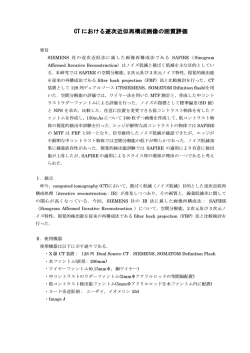
L10-FePd/α-Fe ナノコンポジット磁石における 硬軟磁性相界面の形成と
L10-FePd/α-Fe ナノコンポジット磁石における 硬軟磁性相界面の形成と交換相互作用の発現 (1 京大化研・2 筑波大院数理物質科学) ○佐藤良太 1・大嶋翔 2・寺西利治 1 交 換 結 合 ナノコンポジット磁 石 は、高 磁 化 と高 保 磁 力 を兼 ね備 え得 る高 性 能 (高 い最 大 エネルギー積 ((BH) max )を有 する)永 久 磁 石 として注 目 されており、電 気 自 動 車 用 モーターへの搭 載 を筆 頭 に幅 広 い 分 野 への応 用 が期 待 されている。本 研 究 室 ではこれまでに、無 機 ナノ粒 子 の化 学 的 液 相 合 成 法 を基 軸 とした Pd/γ-Fe 2 O 3 ヘ テロ構 造 ナノ粒 子 の還 元 熱 処 理 による L1 0 -FePd/α-Fe ナノコンポジット磁 石 ((BH) max = 6.0 MGOe)の創製に成功している 1) 。本報告では、従来法に任意量の Pd ナノ粒子を新た に添加することで Fe と Pd のモル比を幅広く調整するとともに、還元熱処理条件を調節することで、L1 0 FePd/α-Fe ナノコンポジット磁石における硬軟磁性相の体積分率と各々の結晶粒径を系統的に制御し、 交換相互作用が最も効果的に発現するナノ構造について詳細な検討を行った。 既報合成法 [1] で得た Pd ナノ粒子(Fig. 1a)と異方性相分離 Pd/γ-Fe 2 O 3 ナノ粒子(Fig. 1b)を任意に混 合することで Fe/Pd モル比を 80/20 ~ 50/50 の範囲で制御し、所定温度で還元熱処理することで L1 0 FePd/α-Fe ナノコンポジット磁石のナノ構造の最適化を試みた。各 条件で得られた試料の(BH) max を比較 すると、773 K で調製した FePd/Fe 体積比が 82/18 の試料において、希土類元素や白金を使用しないナ ノコンポジット磁石としては最高値となる 10.3 MGOe を達成した 2) 。HRTEM 像とその FFT 分析(Fig. 1c-h)から、高い(BH) max を示す試料では、L1 0 -FePd 硬磁性相と α-Fe 軟磁性相の間で明瞭なコヒーレン ト界面の形成が観測され、FORC 解 析 においても交 換 相 互 作 用 の発 現 を直 接 的 に意 味 する同 時 スイッ チングが確認された(Fig. 2a) 2) 。一方、より高温で熱処理した試料では、α-Fe 相の肥大化によるコヒーレ ント界面の消失や交換相互作用の減衰(Fig. 2b)、さらには不規則 fcc-FePd 相への相転移による保磁 力低下などの要因に起因する(BH) max の著しい減少を確認した 2) 。以上の結果は、本システムのさらなる 高性能化や他のナノコンポジット磁石の開発に際し、極めて重要な設計指針となり得る。 Fig. 1. TEM images of (a) 4.9 ± 0.3 nm Pd NPs and (b) Pd/γ-Fe2O3 heterostructured NPs. Structural analysis of L10-FePd/α-Fe (44/56) NCMs formed by annealing Pd/γ-Fe2O3 heterostructured NPs at 723 K. (c) HRTEM images, (d) all FFT spots, (e, g) distinct FFT spots, and (f, h) inverse-FFT images corresponding to panels e, g, respectively. Fig. 2. FORC diagrams of L10-FePd/α-Fe (44/ 56) NCMs formed by annealing Pd/γ-Fe2O3 heterostructured NPs with a Fe/Pd molar ratio of 80/20 under an atmosphere of Ar + 4% H2 for 10 h at (a) 773 and (b) 823 K. 1) T. Teranishi et al., J. Am. Chem. Soc. 2008, 130, 4210–4211. 2) N. Sakuma, T. Ohshima, R. Sato, T. Teranishi et al., ACS Nano 2011, 5, 2806–2814. Exchange Coupling Interaction in L10-FePd/α-Fe Nanocomposite Magnets with Optimum Nanostructure R. SATO1, T. OHSHIMA2, T. TERANISHI1 (1Kyoto Univ., 2Univ. of Tsukuba, [email protected]) Exchange-coupled nanocomposite magnets (NCMs) consisting of hard and soft magnetic phases have attracted much attention as novel permanent magnets. We previously succeeded in fabrication of L10-FePd/α-Fe NCMs by the reductive annealing of Pd/γ-Fe2O3 heterostructured nanoparticles (NPs). Herein we report the structural optimization of L10-FePd/α-Fe NCMs by adjusting the volume fraction of hard/soft phases and the temperature of reductive annealing to obtain large maximum energy products ((BH)max). In the L10-FePd/α-Fe NCMs with the large (BH)max, the interface between the hard and soft phases was coherent and the phase sizes were optimized, both of which effectively induced exchange coupling. This exchange coupling was directly observed by visualizing the magnetic interaction between the hard and soft phases using a first-order reversal curve (FORC) diagram.
© Copyright 2026


